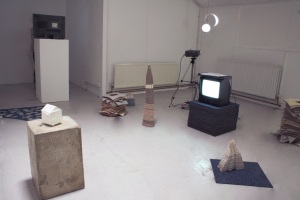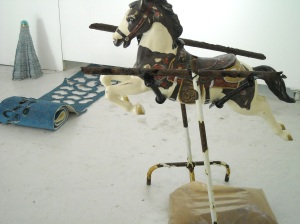Tom Slingsby: It’s really good to be here with Ned McConnell and Tila Rodríguez-Past who are the curators of It’s All About Paradise 2. Ned, can you start by telling us a bit about your background in art?
Ned McConnell: Well I had a slightly strange route into art, I suppose. I didn’t really do any art till I was 19, I didn’t do it for GCSE or A Level, and then I went and did a foundation diploma at Northbrook College, which is just down the road from here. I then went to Edinburgh to study photography. And it was at the end of my time at Northbrook that I started to become interested in video installation and that kind of work. When I got to Napier in Edinburgh I tried to continue down that route. It was a bit difficult because of the structure of the course, they did a lot of commercial photography as well as art photography, but I suppose I just ended up kind of crowbarring it into my own curriculum and making the work that I wanted to make. And they were fine with that. I became interested in curating while I was there, I curated a show for everyone on my course in London which I really enjoyed and got funding from the University for that. And then since I’ve been in Brighton, I’ve been working at Fabrica and had a show in the Photo Fringe last year, Tila was part of that show, and that was how we first met artistically.
TS: And Tila, tell us a bit about your background in art and what your influences are.
Tila Rodríguez-Past: Well my Dad is a photographer and my mum is a poet so I guess I was involved with art since the very beginning by default. I did my BFA in San Francisco and my MA in London. I really liked working with people as a group, and sharing ideas. This project began because Ned and I decided that we needed to do something with the people that we knew from Brighton.
TS: Can you tell me a bit about how the project came about? What were the shared ideas or influences that brought you together?
NM: Well we met through Fabrica, I’ve been volunteering there for about two years which is about the same amount of time that Tila’s been managing there. And I can remember that we went up [to London] to see the Zoo Art Fair as a Fabrica Artist Resource trip, and on the way back we were talking about how we wanted to have a show, but how it can be difficult in Brighton because there’s not a huge amount of spaces for contemporary art. So we just decided that we would try and do it ourselves. After that, we met and talked about the Arts Council and getting some funding through that.
TS: Great. Tila, do you want to take me through the initial ideas of the project and how they began to develop?
TRP: Well like Ned was saying, we went to the Zoo Art Fair in London and we went to a talk by the guy who started Workspace in Gateshead and we were quite inspired about what he had to say about basically starting something with your friends. He said that artists have to keep showing their work and get together and help each other and that things grow from there. And we decided that we didn’t want to wait for an opportunity to come to us, we were going to make one for ourselves and for our friends. Then we met and started talking about having a theme for the exhibition and we wanted it to be quite specific and yet quite open. And we were talking about current social problems, such as the credit crunch and the media: because we live in an age of global, instant media everything happens quicker and quicker. So that’s where the idea for “Resampling”, which was the working title of the exhibition, came from. How culture recycles itself over and over again.
TS: I just want to clarify the idea that you wanted to create a structure for the artists to work within, with rules…
NM: They’re more like guidelines (!).
TS: Okay tell us about the guidelines, and why you felt it was important to have structure.
TRP: We thought it was a good idea because everyone we spoke to felt they were having problems creating focussed work, and we thought it was a good idea to have an exhibition of work specifically made for that exhibition. Just so that the pieces had a theme running through them. One of the first guidelines was that people weren’t allowed to use traditional art materials. And the idea behind that was that we really wanted people to think about what they wanted to say and their way of saying it, instead of thinking about the theme of the project and creating work about it using materials they were used to working with.
TS: Because I suppose then you would end up with more straightforwardly representational work.
TRP: Yes, instead of taking a photograph or making a painting about “Resampling”, we wanted to think about the ideas and what we wanted to say and then find a way of saying it that was, I guess, more efficient. Another part of the structure was the critiques. Everybody met up once a month for nine months and people basically brought their work and discussed it. Everyone had to produce at least once piece for the final show. Another rule was the use of found objects, to link the work back to the idea of “Resampling”. Also we asked people not to make a personal piece, and this was quite important for the exhibition because we wanted the artists to separate from their work and find a sense of humour with it.
TS: Has the idea of “Resampling” changed and developed over the last few months?
NM: In the beginning it was quite a loose idea of the cyclical nature of culture, but as the project moved on it started to become more about the postmodern condition and how that can feel quite claustrophobic. It’s very easy to feel penned-in by the idea of the postmodern condition and the fact that things are used over and over again. But I remember having a conversation with Tila and saying that we shouldn’t necessarily view that reuse as a bad thing. If you can let go of some of the concerns about inauthenticity within art then you can actually use that as a resource, a pool of things that you can pull into your own work and use it as a positive thing.
TRP: When you graduate from art school and you’ve learnt about art history, it can be quite difficult to be creative with your own ideas. We wanted to embrace that within the project and say “actually we are gonna be using ideas that already exist, and hopefully we’re gonna be able to transform them along the way, and make something new”. We wanted to take that problem into consideration and be quite honest about it, I suppose.
TS: One of the things that has struck me recently as the show’s come together is the element of humour that’s come in. Is this a way of dealing with the almost paralysing proliferation of cultures and media that we live with? Has treating these issues in a lighter way liberated the artists?
NM: Definitely. Right from the start of the project we were encouraging people to make something that was a bit more humorous. That’s a big thing within postmodernism, the ironic, slightly dry humour. Postmodernism makes it very easy to be self-deprecating in a humorous way. We’re really pleased that the humour has come through and Aneel Kalsi, the show’s designer, did a really great job with pulling that in as well, with the kind of colour scheme that he used and his use of cartoons.
TS: What were your first impressions of the space at Blank when you first went in and it was still empty? How did you find a way of making the pieces fit together well within the space?
TRP: About a week before we installed the show we had our final critique with the group and we asked everyone to show us their final project and to talk about how they would like it to be exhibited within the space. At that point we were a bit scared that we weren’t gonna have enough space to show everything. So we had to cut it down and we didn’t show all of the work in the end, because we wanted it all to look good together. We had to consider people’s ideas, but also make it work as a whole. It was about seeing the work in the space and playing around with things. It was actually at about three in the morning when Ned and I finally realised how it should look.
NM: I feel that the show has a real sense of self now. One of the things that started to come though when we had the work in the space was the kind of conceptual coherence that we had tried to put into all of the work throughout the project, by having the rules and the critiques, and that certainly made it easier to arrange the work within the space.
TS: You talk about the pieces sharing a sense of self. How has it been investing these found, somewhat anonymous objects with a sense of life? Or did you have to do that?
NM: I think that the context that you see objects in is often what gives them meaning. The way we’ve set out the exhibition, and everything that went before that is what helps give the works a base from which they can speak about their individual issues within the idea of “Resampling”. I think one thing we’ve done really well, given that neither of us had really curated a project of this size before, is given the artists a kind of foil or context for their work to say what they wanted it to say.
TS: And what do you think might happen next within your practise as curators?
TRP: We’d really like to exhibit the show again in London.
NM: Yeah. I’ve really enjoyed curating, and do want to do more, I’m thinking about going more into that side of things over making work. I don’t think I’ll ever stop making work, but I get a lot out of curating.





